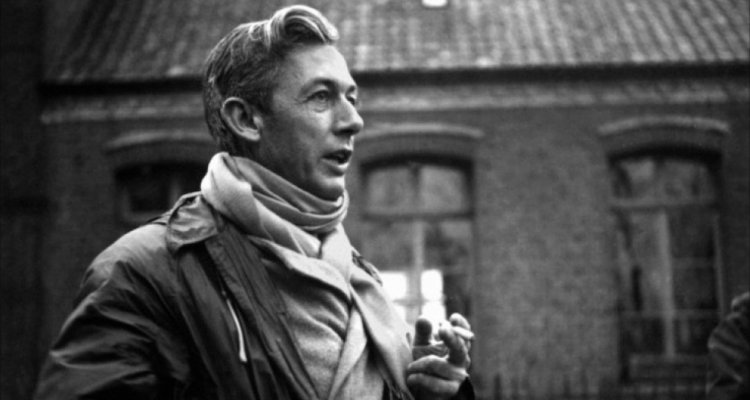 “Au Hasard Balthazar” (1966)
“Au Hasard Balthazar” (1966)
“Everyone who sees this film will be absolutely astonished, because this film is really the world in an hour and a half,” wrote Jean-Luc Godard, a fierce admirer of this 1966 masterpiece. Arguably his finest hour next to “A Man Escaped,” Bresson’s fifth feature is also his most compassionate and emotional, while still retaining that trademark reserve, in the bleak observation of his honest, innocent protagonists’ tragic fates. Deriving inspiration from Dostoyevsky‘s “The Idiot,” the plot chronicles the life of Marie (Anne Wiazemsky, one of the rare Bresson non-pros who went on to a notable acting career afterwards), a shy farm girl, and follows the story of her beloved donkey (which she names Balthazar) as he is passed on from owner to owner — some inhumane, others mildly sympathetic, but mostly tending to the sadistic. Sadly, and ironically, Balthazar’s hellish existence parallels that of Marie as the young girl is similarly emotionally, psychologically and physically abused over the years. A heart-rending and deeply moving picture, which features one of the most noble and powerful “performances” by an animal on screen ever, the largely accepted interpretation of ‘Balthazar’ is as an allegory for a saint who reaches spiritual transcendence by bearing his trials without complaint in the face of exploitation and malice. Whatever the case, there’s no denying that Bresson’s is a cruel, cruel world and this examination of unfair and unjust human suffering is devastating, profound and heartbreaking. [A+]
 “Mouchette” (1967)
“Mouchette” (1967)
The director returned to the work of Georges Bernanos for his first feature following the landmark “Au Hasard Balthazar,” in a quick turnaround which likely influenced the similarly bleak tone. Berated in school and forced to care for her ailing mother and baby sibling at home, the titular character (Nadine Nortier) has little to be cheerful about, with even a moment of potential legitimate human connection at a carnival quickly squashed by her drunkard father. However, she finds herself with a brief sense of purpose after a night with an epileptic poacher — thinking he might have killed a gameskeeper in a scuffle, he makes her part of his alibi and then proceeds to deflower her. This event changes the young girl, who subsequently holds herself more confidently. Regrettably, her inner change does not affect the dreary and impoverished world around her, and she goes on to find the burden of living this existence altogether unbearable. Bresson is often noted to be minimalistic in form, but while he does cut fat like he’s a Yahoo executive, it’s important to note the difference between him and more severely minimalistic filmmakers: scenes are filled with numerous movements and actions, all amplified by the director’s inquisitive camera, and cut together in a specific rhythm. This film arguably has some of the best constructed scenes he’s ever done: the gameskeeper observing the nefarious poacher at work is quiet and mysteriously suspenseful (Hitchcock would be proud), while a scuffle between Mouchette and her schoolteacher over her singing feels like a slice of life, an uncomfortable memory we’d all rather forget. Again, Bresson is working on figures isolated by their societies, but he avoids being repetitive by his consistently striking imagery, such as final moment of Mouchette giving herself to the lake (a sequence again immortalized in 2003 for Bernardo Bertolucci’s “The Dreamers”). A concentrated portrait of human suffering, “Mouchette” is often held in high regard next to its brother ‘Balthazar’ and also received the stamp of approval from Jean-Luc Godard, who cut a trailer for the film, which shows his respect, in his own (of course) “cute” little way. [A]
 “A Gentle Woman” (1969)
“A Gentle Woman” (1969)
Bresson’s first film in color, “Une Femme Douce” (“A Gentle Woman“), is based on the Dostoevsky short story “A Gentle Creature.” The story focuses on the unknowable inner world of ‘the gentle woman,’ Elle, who we meet at the beginning of the film right after she commits suicide. The story is told in flashbacks narrated by her pawnbroker husband, Luc, as he tries to understand what led her to kill herself. They met at his store, and he, struck by her beauty, followed her home, married her despite her initial protestations. An odd pairing from the start, the pawnbroker finds himself unable to fully understand his wife as he wants: he appeals to her with trips to the opera, buying her records and books, but still she isn’t happy. Luc becomes more oppressive and Elle becomes more withdrawn, until one night she reaches for a gun to kill him, but is unable to pull the trigger. Instead she escapes the only way she can, through death — a common escape for Bresson’s characters. As we are told the story from the husband’s point of view, his wife’s world remains mysterious, always hidden just out of frame. Interestingly, though Bresson referred to all his actors as “models,” this one featured an actual 1960s model, Dominique Sanda in her screen debut (she later went on to star in Bertolucci’s “The Conformist”), though oddly enough Sanda was cast on the basis of her voice. The performances are typically Bressonian, with little emotion or reaction given away by expression, though the gentle subtleties of Sanda’s face and movements hint at her inner turmoil. Bresson’s view on materialism vs. spiritual fulfillment are made clear in this film, with hints that the pawnbroker’s obsession with money and “things” led to his wife’s despair, and ergo her death. [B+]

